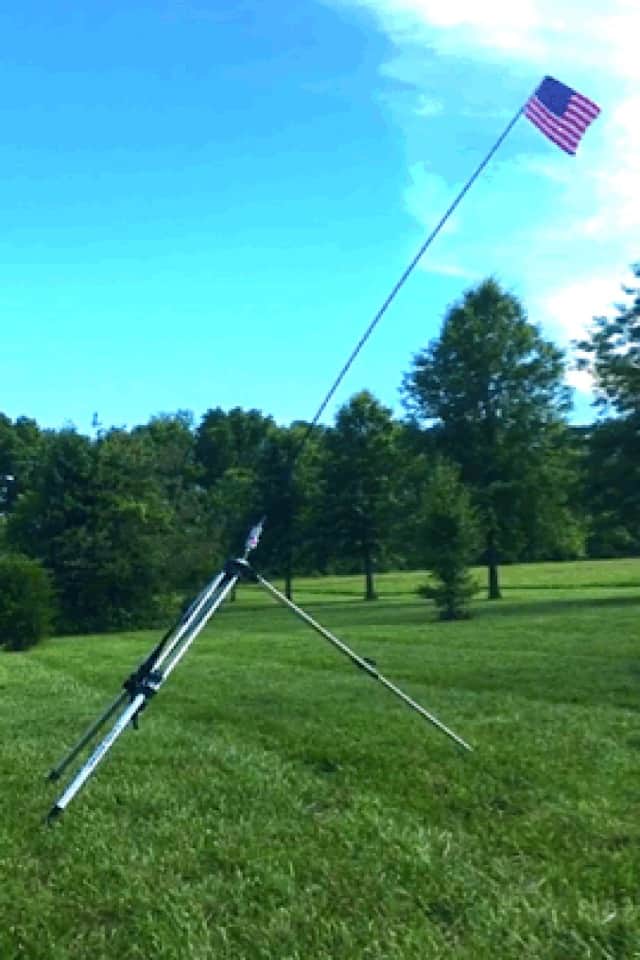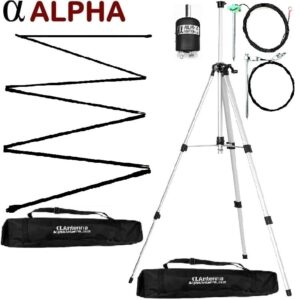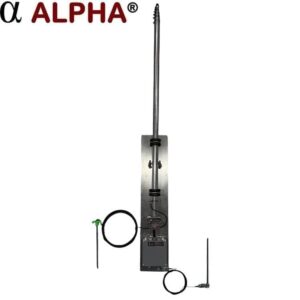Deployment & Signal Pattern
You must deploy the entire ProMaster or HD-FMJ antenna system as directed in the user guide for it to work correctly. Do not leave off either the NVIS or Grounded counterpoise elements thinking that just the Vertical element will work. After deploying the system correctly, your signal will launch away from the NVIS element, and in the direction of where the Grounded Counterpoise is pointing. Try not ‘point’ your signal at a building, vehicle, or hillside, but instead launch your signal at the most free and clear shot of the horizon as possible.
For an omnidirectional signal pattern, you may install 4 optional 35′ NVIS elements.
SWR and Loss
Per the chart below, 100 watts ERP at an SWR of 1.0:1 becomes 88.9 watts when your SWR is 2.0:1. To add 1 S-Unit to your transmitted signal, you need to increase your power by 100%. This means that a difference of 1 SWR unit puts your loss right at about 1/10th of an S-Unit, and that is pretty much undetectable. You can, however, use our FAQs section below to resolve extreme or even subtle SWR issues as in our example.
* ERP = Percentage of Effective Radiated Power
| SWR READING | % OF LOSS | ERP* | WATTS AVAILABLE |
| 1.0:1 | 0.0% | 100.0% | 4.00 |
| 1.1:1 | 0.2% | 99.8% | 3.99 |
| 1.2:1 | 0.8% | 99.2% | 3.97 |
| 1.3:1 | 1.7% | 98.3% | 3.93 |
| 1.4:1 | 2.8% | 97.2% | 3.89 |
| 1.5:1 | 4.0% | 96.0% | 3.84 |
| 1.6:1 | 5.3% | 94.7% | 3.79 |
| 1.7:1 | 6.7% | 93.3% | 3.73 |
| 1.8:1 | 8.2% | 91.8% | 3.67 |
| 1.9:1 | 9.6% | 90.4% | 3.61 |
| 2.0:1 | 11.1% | 88.9% | 3.56 |
| 2.1:1 | 12.6% | 87.4% | 3.50 |
| 2.2:1 | 14.1% | 85.9% | 3.44 |
| 2.3:1 | 15.5% | 84.5% | 3.38 |
| 2.4:1 | 17.0% | 83.0% | 3.32 |
| 2.5:1 | 18.4% | 81.6% | 3.27 |
| 2.6:1 | 19.8% | 80.2% | 3.21 |
| 2.7:1 | 21.1% | 78.9% | 3.16 |
| 2.8:1 | 22.4% | 77.6% | 3.10 |
| 2.9:1 | 23.7% | 76.3% | 3.05 |
| 3.0:1 | 25.0% | 75.0% | 3.00 |
| 4.0:1 | 36.0% | 64.0% | 2.56 |
| 5.0:1 | 44.4% | 55.6% | 2.22 |
| 6.0:1 | 51.0% | 49.0% | 1.96 |
| 7.0:1 | 56.3% | 43.8% | 1.75 |
| 8.0:1 | 60.5% | 39.5% | 1.58 |
| 9.0:1 | 64.0% | 36.0% | 1.44 |
| 10.0:1 | 66.9% | 33.1% | 1.32 |
Antenna Placement
To minimize the effect on SWR and Performance, place the antenna 18 or more feet from surrounding structures. This will also often help lower noise floors, which exists when an antenna is placed close to a structure that might generate electrical interference.
Coax Selection
When selecting your coax, please use a 50-ohm coax that is longer than the included 8-foot ground wire. This way the antenna will see that 8-foot wire has the path of least resistance to ground, rather than your equipment.
FAQs
If you are having an issue, please check the user guide to ensure that you have the antenna fully deployed using all three elements (Vertical, NVIS, & Ground wire).
We will occasionally be asked why SWR or Performance is different when an operator deploys this portable antenna at one location vs another. The largest factor is ground conditions. If, for example, you are deployed over black dirt then you will have a much better ground than if you are deployed in a clay or rocky environment. A better ground will result in lower SWRs, less common mode current, and improve your signal. This is why deployments over a marshy salt-water environment provides incredible results for both SWR and Performance.
Here are some tips if you are having an SWR at or above 2.9:1 that may help.
NOTE – Modern day rigs do not fold back power till an SWR of 2.9:1 is reached for a very specific reason. That reason is that manufacturers have deemed an SWR of 2.9:1 is ok and will not harm finals.
- If you are experiencing infinite SWR, try another section of coax, just in case the one you are using has developed a short.
- To improve SWR and Performance, do not run your coax in parallel with the NVIS or Grounded Counterpoise elements, but instead, run your coax at about 45 degrees from them.
- To improve SWR, ensure your coax does not coil up at any point between your equipment and the antenna.
- If you are experiencing high noise levels, common mode, or irregular SWR reading then install an air choke between the antenna and your equipment. Where approximately 16 turns of coax formed into a 7 to 8 inch loop held together with zip ties will do it.
- SWR readings taken at your station’s operating position can be much different than those taken at the antenna. So, SWR readings should always be taken at the antenna using a short jumper Coax.
- Again, if you are experiencing low performance or higher than expected SWR, then check if your antenna is at least 18 feet from structures.
Antenna Positioning
Positioning the Alpha Antenna system, as shown in the image on this post on our HD Tripod, will change the launch pattern of your signal. In this configuration, the take-off angle is raised farther off the horizon when the NVIS is deployed in the direction of the sloping system. When the NVIS is deployed in the opposite direction, the take-off angle is lower. Assuming in both deployments the Grounded Counterpoise is run in the opposite direction of the NVIS Element.
Read more tips about the FMJ antenna HERE
Read more tips about the ProMaster antenna HERE
-
6-80M Portable HF Antenna (MIL EmComm Deluxe)$519.00Rated 4.97 out of 5 based on 112 customer ratings
-
6-80M Portable HF Antenna (MIL EmComm Basic)$400.00Rated 5.00 out of 5 based on 84 customer ratings
-
10-80M HF Base Antenna (ProMaster)$600.00Rated 4.94 out of 5 based on 32 customer ratings




